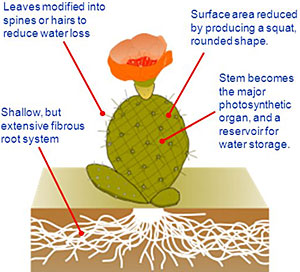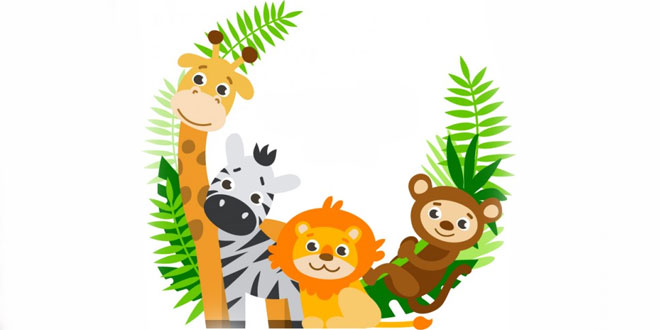Question: Write the adaptation of cactus.
Answer:

Cactus:
- It has long roots so that it can go deep into the soil in search of water.
- Their leaves are converted into spines to prevent loss of water by transpiration.
- They have fleshy stems to store water, they are succulent plants.
- The stem is covered with a thick waxy layer that helps to retain water.
Question: What is habitat?
Answer: Habitat is a living or a dwelling of an organism which provides it with food, air, water, shelter and place to raise their young ones.
Question: List various habitats.
Answer: Types of habitat:
Aquatic habitats:
- Marine habitats
- Freshwater habitats
- Coastal habitats
Terrestrial habitats:
- Desert habitats
- Grassland habitats
- Rain forest habitats
- Tundra or polar habitats
Question: Briefly explain adaptations of camels.
Answer: Adaption of Camel:
- It stores fats in its hump.
- It has long legs to keep its body away from hot sand.
- It has broad padded fat to move on soft sand.
- It’s dung is dry and passes little water in wine.
- It has thick eyelashes and downwards nostril to prevent it from dust.
- It has strong tongue to eat thorny cactus.
- It can increase its body temperature to prevent sweating.
- It has thick skin to prevent sweating also.
Question: Explain the adaptation of polar plants.
Answer: Adaptations of polar plants in hilly areas.
- The leaves are needle-shaped to prevent loss of water by transpiration.
- The leaves are needle-shaped so that the snow can slide off without breaking the branches.
- The trees are tall so that they can receive enough sunlight.
- They do not shed their leaves because they are evergreen.
- The soil is not rich because the soil is not fertile because of the cold temperature.
Question: Briefly explain adaptations of polar bear.
Answer:
- It has thick fur to trap the body heat.
- It has white fur for camouflage and matching surrounding.
- It hibernates in winters or extreme cold weather.
- It has layer of fat called blubber to trap the body heat.
- Sharp clues and teeth to tear flesh.
Question: How does hibernation help dormouse?
Answer:
- Hibernating the organisms hides itself in burrows and caves which protect it from cold.
- Number of physical activities get reduced and this saves energy which is used in keeping the body warm.
Question: Give an example of an animal that used camouflage to escape from enemies and another that uses camouflage to catch its prey. Explain how the camouflage helps each of them.
Answer: Stick insect uses camouflage to escape from enemies and snake used camouflage to catch its prey. Camouflage helps stick insect to look like a stick which makes the productor difficult to see the prey.
Question: Lions have eyes in front while deer have eyes on the side. Why?
Answer: Lions have eyes in front of their faces this help to give them a correct idea about the location of their prey. Deer also live in grassland. They have eyes on the side of their heads. This enables them to look in all directions for danger.
Question: Suppose a scientist up a medicine that could kill all bacteria and fungi and give it to used. Would you used it or not? Why?
Answer: I would not use it because our environment requires good bacteria for decomposing and our body also needs them to return nutrients back to the nutrient pool.
 Class Notes NCERT Solutions for CBSE Students
Class Notes NCERT Solutions for CBSE Students


